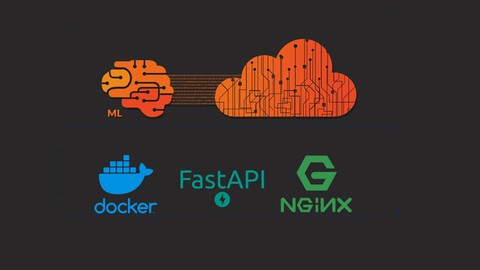
2024 Deploy ML Model in Production with FastAPI and Docker
2024 Deploy ML Model in Production with FastAPI and Docker, available at $74.99, has an average rating of 4.75, with 247 lectures, based on 403 reviews, and has 18905 subscribers.
You will learn about Deploy Machine Learning Models with FastAPI: Learn to build and deploy RESTful APIs for serving ML models efficiently. Master Cloud-Based ML Deployments with AWS: Gain hands-on experience deploying, managing, and scaling ML models on AWS EC2 and S3. Automate ML Operations with Boto3 and Python: Automate cloud tasks like instance creation, data storage, and security configuration using Boto3. Containerize ML Applications Using Docker: Build and manage Docker containers to ensure consistent and scalable ML deployments across environments. Streamline Model Inference with Real-Time APIs: Develop high-performance APIs that deliver fast and accurate predictions for production-grade applications. Optimize Machine Learning Pipelines for Production: Design and implement end-to-end ML pipelines, from data ingestion to model deployment, using best practices. Implement Secure and Scalable ML Infrastructure: Learn to integrate security protocols and scalability features into your cloud-based ML deployments. Create Interactive Web Apps with Streamlit: Build and deploy interactive ML-powered web applications that are accessible and user-friendly. Deploy Transformers for NLP and Computer Vision: Fine-tune and deploy TinyBERT and Vision Transformers for sentiment analysis, disaster tweets, and images. Monitor and Maintain ML Models in Production: Implement monitoring, A/B testing, and bias detection to ensure your models remain reliable and effective in prod. This course is ideal for individuals who are Machine learning engineers who want to gain hands-on experience in setting up and configuring an end-to-end machine learning production pipeline. or Data Scientists and Machine Learning Engineers: Professionals looking to advance their skills in deploying machine learning models in production environments using FastAPI, AWS, and Docker. or Cloud Engineers and DevOps Professionals: Individuals who want to master cloud-based deployments, automate ML pipelines, and manage scalable infrastructure on AWS. or Software Developers and Engineers: Developers interested in integrating machine learning models into applications and services, with a focus on API development and containerization. or AI Enthusiasts and Practitioners: Anyone passionate about AI and machine learning who wants to gain hands-on experience in taking models from development to deployment. or Tech Professionals Transitioning into ML Ops: IT professionals or developers transitioning into machine learning operations (ML Ops) who need practical knowledge of production-grade deployment and automation tools. It is particularly useful for Machine learning engineers who want to gain hands-on experience in setting up and configuring an end-to-end machine learning production pipeline. or Data Scientists and Machine Learning Engineers: Professionals looking to advance their skills in deploying machine learning models in production environments using FastAPI, AWS, and Docker. or Cloud Engineers and DevOps Professionals: Individuals who want to master cloud-based deployments, automate ML pipelines, and manage scalable infrastructure on AWS. or Software Developers and Engineers: Developers interested in integrating machine learning models into applications and services, with a focus on API development and containerization. or AI Enthusiasts and Practitioners: Anyone passionate about AI and machine learning who wants to gain hands-on experience in taking models from development to deployment. or Tech Professionals Transitioning into ML Ops: IT professionals or developers transitioning into machine learning operations (ML Ops) who need practical knowledge of production-grade deployment and automation tools.
Enroll now: 2024 Deploy ML Model in Production with FastAPI and Docker
Summary
Title: 2024 Deploy ML Model in Production with FastAPI and Docker
Price: $74.99
Average Rating: 4.75
Number of Lectures: 247
Number of Published Lectures: 247
Number of Curriculum Items: 247
Number of Published Curriculum Objects: 247
Original Price: $199.99
Quality Status: approved
Status: Live
What You Will Learn
- Deploy Machine Learning Models with FastAPI: Learn to build and deploy RESTful APIs for serving ML models efficiently.
- Master Cloud-Based ML Deployments with AWS: Gain hands-on experience deploying, managing, and scaling ML models on AWS EC2 and S3.
- Automate ML Operations with Boto3 and Python: Automate cloud tasks like instance creation, data storage, and security configuration using Boto3.
- Containerize ML Applications Using Docker: Build and manage Docker containers to ensure consistent and scalable ML deployments across environments.
- Streamline Model Inference with Real-Time APIs: Develop high-performance APIs that deliver fast and accurate predictions for production-grade applications.
- Optimize Machine Learning Pipelines for Production: Design and implement end-to-end ML pipelines, from data ingestion to model deployment, using best practices.
- Implement Secure and Scalable ML Infrastructure: Learn to integrate security protocols and scalability features into your cloud-based ML deployments.
- Create Interactive Web Apps with Streamlit: Build and deploy interactive ML-powered web applications that are accessible and user-friendly.
- Deploy Transformers for NLP and Computer Vision: Fine-tune and deploy TinyBERT and Vision Transformers for sentiment analysis, disaster tweets, and images.
- Monitor and Maintain ML Models in Production: Implement monitoring, A/B testing, and bias detection to ensure your models remain reliable and effective in prod.
Who Should Attend
- Machine learning engineers who want to gain hands-on experience in setting up and configuring an end-to-end machine learning production pipeline.
- Data Scientists and Machine Learning Engineers: Professionals looking to advance their skills in deploying machine learning models in production environments using FastAPI, AWS, and Docker.
- Cloud Engineers and DevOps Professionals: Individuals who want to master cloud-based deployments, automate ML pipelines, and manage scalable infrastructure on AWS.
- Software Developers and Engineers: Developers interested in integrating machine learning models into applications and services, with a focus on API development and containerization.
- AI Enthusiasts and Practitioners: Anyone passionate about AI and machine learning who wants to gain hands-on experience in taking models from development to deployment.
- Tech Professionals Transitioning into ML Ops: IT professionals or developers transitioning into machine learning operations (ML Ops) who need practical knowledge of production-grade deployment and automation tools.
Target Audiences
- Machine learning engineers who want to gain hands-on experience in setting up and configuring an end-to-end machine learning production pipeline.
- Data Scientists and Machine Learning Engineers: Professionals looking to advance their skills in deploying machine learning models in production environments using FastAPI, AWS, and Docker.
- Cloud Engineers and DevOps Professionals: Individuals who want to master cloud-based deployments, automate ML pipelines, and manage scalable infrastructure on AWS.
- Software Developers and Engineers: Developers interested in integrating machine learning models into applications and services, with a focus on API development and containerization.
- AI Enthusiasts and Practitioners: Anyone passionate about AI and machine learning who wants to gain hands-on experience in taking models from development to deployment.
- Tech Professionals Transitioning into ML Ops: IT professionals or developers transitioning into machine learning operations (ML Ops) who need practical knowledge of production-grade deployment and automation tools.
Welcome to Production-Grade ML Model Deployment with FastAPI, AWS, Docker, and NGINX!
Unlock the power of seamless ML model deployment with our comprehensive course, Production-Grade ML Model Deployment with FastAPI, AWS, Docker, and NGINX. This course is designed for data scientists, machine learning engineers, and cloud practitioners who are ready to take their models from development to production. You’ll gain the skills needed to deploy, scale, and manage your machine learning models in real-world environments, ensuring they are robust, scalable, and secure.
What You Will Learn:
-
Streamline ML Operations with FastAPI: Master the art of serving machine learning models using FastAPI, one of the fastest-growing web frameworks. Learn to build robust RESTful APIs that facilitate quick and efficient model inference, ensuring your ML solutions are both accessible and scalable.
-
Harness the Power of AWS for Scalable Deployments: Leverage AWS services like EC2, S3, ECR, and Fargate to deploy and manage your ML models in the cloud. Gain hands-on experience automating deployments with Boto3, integrating models with AWS infrastructure, and ensuring they are secure, reliable, and cost-efficient.
-
Containerize Your Applications with Docker: Discover the flexibility of Docker to containerize your ML applications. Learn how to build, deploy, and manage Docker containers, ensuring your models run consistently across different environments, from development to production.
-
Build and Deploy End-to-End ML Pipelines: Understand the intricacies of ML Ops by constructing end-to-end machine learning pipelines. Explore data management, model monitoring, A/B testing, and more, ensuring your models perform optimally at every stage of the lifecycle.
-
Automate Deployments with Boto3: Automate the deployment of your ML models using Python and Boto3. From launching EC2 instances to managing S3 buckets, streamline cloud operations, making your deployments faster and more efficient.
-
Scale ML Models with NGINX: Learn to use NGINX with Docker-Compose to scale your ML applications across multiple instances, ensuring high availability and performance in production.
-
Deploy Serverless ML Models with AWS Fargate: Dive into serverless deployment using AWS Fargate, and learn how to package, deploy, and manage ML models with AWS ECR and ECS for scalable, serverless applications.
-
Real-World ML Use Cases: Apply your knowledge to real-world scenarios by deploying models for sentiment analysis, disaster tweet classification, and human pose estimation. Using cutting-edge transformers and computer vision techniques, you’ll gain practical experience in bringing AI to life.
-
Deploy Interactive ML Applications with Streamlit: Create and deploy interactive web applications using Streamlit. Integrate your FastAPI-powered models into user-friendly interfaces, making your ML solutions accessible to non-technical users.
-
Monitor and Optimize Production ML Models: Implement load testing, monitoring, and performance optimization techniques to ensure your models remain reliable and efficient in production environments.
Why This Course?
In today’s fast-paced tech landscape, the ability to deploy machine learning models into production is a highly sought-after skill. This course combines the latest technologies—FastAPI, AWS, Docker, NGINX, and Streamlit—into one powerful learning journey. Whether you’re looking to advance your career or enhance your skill set, this course provides everything you need to deploy, scale, and manage production-grade ML models with confidence.
By the end of this course, you’ll have the expertise to deploy machine learning models that are not only effective but also scalable, secure, and ready for production in real-world environments. Join us and take the next step in your machine-learning journey!
Course Curriculum
Chapter 1: Introduction
Lecture 1: Course Introduction
Lecture 2: Install Requirements.txt
Lecture 3: Resources [Code Files]
Chapter 2: Introduction to ML Ops and Pipeline
Lecture 1: What is Machine Learning Pipeline
Lecture 2: Type of ML Model Deployment
Lecture 3: ML Infrastructure and Integration Tools
Lecture 4: Benefits of ML Pipeline
Lecture 5: Challenges in ML Model Deployment
Lecture 6: Data and Model Management
Lecture 7: A/B Testing for ML Model
Lecture 8: ML Model Bias and Security
Chapter 3: Introduction to AWS Services
Lecture 1: Getting Started with AWS
Lecture 2: Exploring EC2 Dashboard
Lecture 3: AWS Cost Calculator
Lecture 4: Creating EC2 Windows Server Part 1
Lecture 5: Creating EC2 Windows Server Part 2
Lecture 6: Create EC2 Ubuntu Machine
Lecture 7: Create S3 Bucket
Chapter 4: Managing AWS EC2 Servers with Boto3
Lecture 1: Introduction
Lecture 2: AWS Credentials Setup with AWS CLI for Boto3
Lecture 3: AWS Boto3 – SSH Key Pair Setup
Lecture 4: AWS Boto3 – Launch EC2 with Python Part 1
Lecture 5: AWS Boto3 – Launch EC2 with Python Part 2
Lecture 6: AWS Boto3 – Exploring Security Groups using AWS Console
Lecture 7: AWS Boto3 – Create Custom Security Group with Python
Lecture 8: AWS Boto3 – Configure Custom Security Group Using Python
Lecture 9: AWS Boto 3 – Attach and Detach Security Groups to EC2 with Python
Lecture 10: AWS Boto3 – Check EC2 Instance Status
Lecture 11: AWS Boto3 – Start, Stop and Terminate EC2 Instance with Python
Chapter 5: Managing AWS S3 with Boto3
Lecture 1: Introduction
Lecture 2: AWS Boto3 – Create S3 Bucket with Python
Lecture 3: AWS Boto3 – Upload File to S3 with Python
Lecture 4: AWS Boto3 – List S3 Objects or Files in the Bucket
Lecture 5: AWS Boto3 – Download S3 File to Local System
Lecture 6: AWS Boto3 – Upload All Files in Dir to S3 using Python
Lecture 7: AWS Boto3 – Download Full S3 Dir to Local
Lecture 8: AWS Boto3 – Delete All Files in an S3 Bucket
Chapter 6: Sentiment Classification using TinyBERT Transformer
Lecture 1: Introduction
Lecture 2: Getting Started with Sentiment Classification
Lecture 3: Load Data with Hugging Face Datasets Library
Lecture 4: Data Tokenization
Lecture 5: Build Model Evaluation Function
Lecture 6: Model Building and Training
Lecture 7: Model Save and Load for Inference
Lecture 8: Push Model to AWS S3 Part 1
Lecture 9: Push Model to AWS S3 Part 2
Chapter 7: Disaster Tweets Classification using TinyBERT Transformer
Lecture 1: Introduction
Lecture 2: Getting Started with Disaster Tweets Classification
Lecture 3: Loading Disaster Tweets
Lecture 4: Load Data with Hugging Face Datasets Library
Lecture 5: Tweets Tokenization
Lecture 6: Model Building and Training
Lecture 7: Model Save and Load for Inference
Lecture 8: Push Model to AWS S3
Chapter 8: Human Pose Image Classification using Vision Transformers (ViT)
Lecture 1: Introduction
Lecture 2: Getting Started with Image Classification
Lecture 3: Human Pose Dataset Preparation
Lecture 4: Image Preprocessing Part 1
Lecture 5: Image Preprocessing Part 2
Lecture 6: ViT Model Building
Lecture 7: Vision Transformer (ViT) Fine Tuning
Lecture 8: Model Prediction on Test Dataset
Lecture 9: Classification Report and Confusion Matrix
Lecture 10: Human Pose Prediction on Real Images
Lecture 11: Push Model to AWS S3
Chapter 9: Deploy ML Model at Streamlit Server
Lecture 1: Introduction
Lecture 2: Streamlit Application Walkthrough
Lecture 3: Streamlit Basics Part 1
Lecture 4: Streamlit Basics Part 2
Lecture 5: Streamlit Basics Part 3
Lecture 6: Streamlit Basics Part 4
Lecture 7: Streamlit Basics Part 5
Lecture 8: Streamlit Basics Part 6
Lecture 9: Streamlit App with ML Model Part 1
Lecture 10: Streamlit App with ML Model Part 2
Lecture 11: Upload Streamlit App on GitHub for Pipeline
Lecture 12: Deploying ML App at Streamlit Server
Chapter 10: ML Model Deployment with Streamlit at AWS EC2 Server
Lecture 1: Introduction
Lecture 2: Automating AWS EC2 Instance Creation with Boto3
Lecture 3: Automating Security Group Configuration
Lecture 4: Automating Server Start and Stop
Lecture 5: Create Instance with Automated Script
Lecture 6: Terminate Instance
Lecture 7: Fasted and Shortest Way to Create Server During POC
Lecture 8: Connect with SSH to Your Server
Lecture 9: Connect VS Code with the Server
Lecture 10: Connect GitHub with the Server
Lecture 11: Run Streamlit on AWS Server
Lecture 12: Create S3 Full Access and Attach to EC2 Server
Lecture 13: Run Streamlit Application Automatically and Server Start Up
Instructors
-
Laxmi Kant | KGP Talkie
AVP, Data Science Join Ventures | IIT Kharagpur | KGPTalkie
Rating Distribution
- 1 stars: 12 votes
- 2 stars: 12 votes
- 3 stars: 24 votes
- 4 stars: 95 votes
- 5 stars: 260 votes
Frequently Asked Questions
How long do I have access to the course materials?
You can view and review the lecture materials indefinitely, like an on-demand channel.
Can I take my courses with me wherever I go?
Definitely! If you have an internet connection, courses on Udemy are available on any device at any time. If you don’t have an internet connection, some instructors also let their students download course lectures. That’s up to the instructor though, so make sure you get on their good side!
You may also like
- Best Yoga Instruction Courses to Learn in March 2025
- Best Stress Management Courses to Learn in March 2025
- Best Mindfulness Meditation Courses to Learn in March 2025
- Best Life Coaching Courses to Learn in March 2025
- Best Career Development Courses to Learn in March 2025
- Best Relationship Building Courses to Learn in March 2025
- Best Parenting Skills Courses to Learn in March 2025
- Best Home Improvement Courses to Learn in March 2025
- Best Gardening Courses to Learn in March 2025
- Best Sewing And Knitting Courses to Learn in March 2025
- Best Interior Design Courses to Learn in March 2025
- Best Writing Courses Courses to Learn in March 2025
- Best Storytelling Courses to Learn in March 2025
- Best Creativity Workshops Courses to Learn in March 2025
- Best Resilience Training Courses to Learn in March 2025
- Best Emotional Intelligence Courses to Learn in March 2025
- Best Time Management Courses to Learn in March 2025
- Best Remote Work Strategies Courses to Learn in March 2025
- Best Freelancing Courses to Learn in March 2025
- Best E-commerce Strategies Courses to Learn in March 2025






















